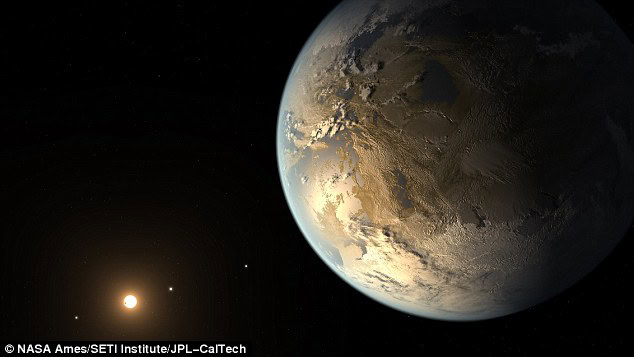WASHINGTON (Web Desk) – Astronomers may be preparing to announce the discovery of a planet similar to Earth that has been found orbiting another star.
Nasa is due to hold a news conference on Thursday to reveal the latest discoveries from its Kepler Space Telescope, which has been scouring the skies for planets outside our own solar system.
The telescope has discovered more than 1,000 of these so-called exoplanets since it was launched in 2009.
In its announcement for the press conference, Nasa suggested it could be about to reveal the discovery of ‘another Earth’.
It said: ‘The first exoplanet orbiting another star like our sun was discovered in 1995
‘Exoplanets, especially small Earth-size worlds, belonged within the realm of science fiction just 21 years ago.
‘Today, and thousands of discoveries later, astronomers are on the cusp of finding something people have dreamed about for thousands of years – another Earth.’
Orbiting around around the sun around 93 million miles (150 million km) from Earth, the Kepler Space Telescope has discovered 1,028 planets and 4,661 candidate planets during its mission.
It has been searching six specific areas of the sky for minute changes in the brightness of stars that may indicate a planet, or planets, passing in front it.
By watching these fluctuations in brightness, it is possible to work out the size and orbit of a planet in relation to its star.
So far astronomers have discovered eight planets that could be candidates for life using data beamed back by the telescope.
Many of those planets in the so-called habitable zone – the area around a star where liquid water might form on a planet’s surface – most are at least 40% larger than Earth.
Last year astronomers announced the telescope had spotted its first Earth-sized planet in the habitable zone of another star.
The Kepler Space Telescope, shown in the artists impression above, has discovered 1,028 confirmed exoplanets since launching in 2009. Astronomers have moved its position of view regularly (shown by the crosses in the image, to watch for tiny changes in brightness from stars that may indicate an orbiting planet
The Kepler Space Telescope, shown in the artists impression above, has discovered 1,028 confirmed exoplanets since launching in 2009. Astronomers have moved its position of view regularly (shown by the crosses in the image, to watch for tiny changes in brightness from stars that may indicate an orbiting planet
In January this year Nasa announced it had discovered eight planets similar to the size of Earth within the habitable zone around the stars they orbited, as shown in the graphic above
In January this year Nasa announced it had discovered eight planets similar to the size of Earth within the habitable zone around the stars they orbited, as shown in the graphic above
Kepler-186f, which is around 500 light years from Earth, was the first planet to be discovered that is reminiscent of our own.
In January this year Nasa announced another two new planets – Kepler 438b, which is thought to be only 12 per cent bigger than Earth, and Kepler-442b, which is thought to be 33 per cent bigger.
In July, Kepler spotted five planets orbiting around the same star – Kepler-444 – all of which are thought to be close to the size of Earth.
Kepler telescope discovered Kepler-186f planet last year
Paul Hertz, director of astrophysics at Nasa, said identifying worlds that could be home to alien life with Kepler would allow future missions to look at them more closely.
He said: ‘Future NASA missions, like the Transiting Exoplanet Survey Satellite and the James Webb Space Telescope, will discover the nearest rocky exoplanets and determine their composition and atmospheric conditions, continuing humankind’s quest to find truly Earth-like worlds.














